Proteomics is the study of the complete protein complement of a cell, tissue, or organism under a precise, defined set of conditions. It is depended on technological and instrumental developments. These developments comprised of advances in mass spectrometry (MS) technology, protein fractionation techniques, bioinformatics, etc. Proteomics depend on three basic technological bases that include a method to fractionate compound protein or peptide mixtures, MS to acquire the data necessary to classify individual proteins and bioinformatics to analyze and assemble the MS data.
The word “proteome” represents the complete protein pool of an organism encoded by the genome. In broader term, Proteomics, is defined as the total protein content of a cell or that of an organism. Proteomics helps in understanding of alteration in protein expression during different stages of life cycle or under stress condition. Likewise, Proteomics helps in understanding the structure and function of different proteins as well as protein-protein interactions of an organism.
Download Sample PDF Brochure, Click Here!
Types of ProteomicsExpression proteomics: The quantitative study of protein expression between samples thatdiffer by some variable is known as expression proteomics. Using this approach, protein expression of the entire proteome or of subproteomes between samples can be compared. This could be useful in identification of disease specific proteins.
Structural proteomics: Unlike comparing the same cell or tissue in normal and diseased state inexpression proteomics, structural proteomics are directed to map out the structure and nature of protein complexes present specifically in a particular cellular organelle. The aim is to identify all proteins present in a complex and to characterize all protein-protein interactions occurring between these proteins.
Functional proteomics: Functional proteomics is a very broad term for many specific, directedproteomics approaches. It can be defined as the use of proteomics methods to analyze the properties of molecular networks involved in a living cell. One of the major objectives is to identify molecules that participate in these networks.
Genes and Proteins
Number of genes vs Number of proteins
Analysis of mRNA does not provide a direct reflection of the protein content in the cell. One reason is that mRNA and protein expression levels do not always correlate. mRNA could undergo various post-transcriptional modifications like, polyadenylation and mRNA editing. Some of these modifications could lead to the generation of various protein forms from a single gene. Subsequently, translational regulation of mRNA could take place. Proteins, after synthesis, could undergo post-translational modifications. It is estimated that proteins could undergo as many as 200 different types of these modifications.





No comments:
Post a Comment